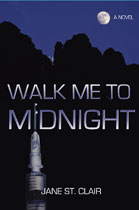Insects of the Sonoran Desert by Jane St. Clair
Today, children, we’re going  to look at insects of the Sonoran Desert, many of which are totally disgusting or deadly poisonous.
to look at insects of the Sonoran Desert, many of which are totally disgusting or deadly poisonous.
Tarantula Spider
 Tarantula spiders are scientifically known as big hairy spiders. In James Bond movies, the bad guy will put a tarantula in James Bond’s bed, and it’ll crawl slowly up his arm before 007 reaches for his gun and blows it away.
Tarantula spiders are scientifically known as big hairy spiders. In James Bond movies, the bad guy will put a tarantula in James Bond’s bed, and it’ll crawl slowly up his arm before 007 reaches for his gun and blows it away.  In real life, tarantulas are timid and shy. They’ll run away from you like scared little mice. You”ll only see them when it rains, which is also when Tarantula Hawks go hunting for them.
In real life, tarantulas are timid and shy. They’ll run away from you like scared little mice. You”ll only see them when it rains, which is also when Tarantula Hawks go hunting for them.
Tarantula Hawk
Despite its name, the Tarantula Hawk is neither bird nor spider. It is a mean little insect with a bizarre life cycle that makes you wonder about the wisdom of evolution. Its sting is so painful that 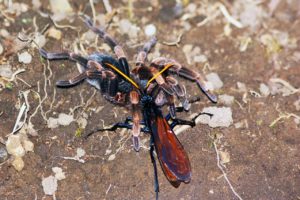 the foremost expert on insects of the Sonoran Desert says when a tarantula hawk bites you, you lose your senses so that no one understands your babbling. The correct thing to do, he advises, is to lie down and start screaming.
the foremost expert on insects of the Sonoran Desert says when a tarantula hawk bites you, you lose your senses so that no one understands your babbling. The correct thing to do, he advises, is to lie down and start screaming.
A female Tarantula Hawk needs to find a big fat tarantula spider in order to survive. Although the Tarantula Spider is gigantic and maybe twenty times bigger than she is, the hawk takes him on. Her sting is so strong that the odds of the spider surviving are 400 to one. She stings him into paralysis, and then lays her eggs into his body. Somehow this is part of nature’s beautiful plan.
Brown Recluse Spider
 The name of this spider brings to mind your old-maid aunt with her brown hair in a bun who teaches piano. However, the brown recluse is a nasty Sonoran Desert insect
The name of this spider brings to mind your old-maid aunt with her brown hair in a bun who teaches piano. However, the brown recluse is a nasty Sonoran Desert insect 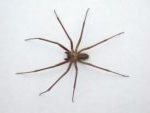 that hides in linen cabinets, and bites you when you grab a towel. His bite is very serious, causing a big red ulcer that needs medical treatment for months and months, and in some cases, until the end of your natural life.
that hides in linen cabinets, and bites you when you grab a towel. His bite is very serious, causing a big red ulcer that needs medical treatment for months and months, and in some cases, until the end of your natural life.
Scorpions
Scorpions are among the most common insects of the Sonoran Desert. The big ones get up to five and a half inches long, 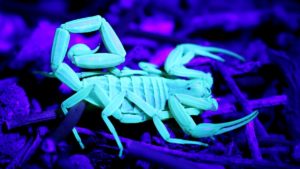 but it’s the little ones that you have to watch out for. They have the nastiest stings. They feel like needle pricks when they get you, but they have this poison that causes nerve damage. Again, part of nature’s perfect plan. One neat thing about scorpions is they glow green in the dark if you shine a black light on them.
but it’s the little ones that you have to watch out for. They have the nastiest stings. They feel like needle pricks when they get you, but they have this poison that causes nerve damage. Again, part of nature’s perfect plan. One neat thing about scorpions is they glow green in the dark if you shine a black light on them.
Giant Red-Headed Centipedes
A giant Red-Headed Centipede can be a foot long, or so claim Texans who are known to tell a tall tale or two. We have gigantic centipedes here in Tucson, and
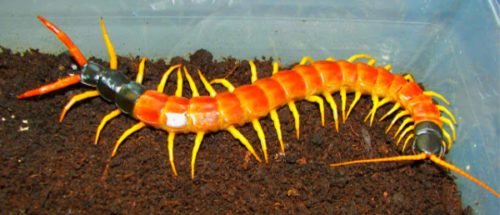
I’d pit ours against theirs any day, although I’ve never seen a 12-inch one. They grow big enough to eat lizards and toads. Sadly, these Giant Red-Headed Centipedes are partly why we redheads have such a bad name. They say a Civil War soldier died when a Giant Redheaded Centipede used his little feet to cover him in bites. However, let’s be careful because this is a story told by Texans.
Killer Bees
 We share our beautiful Sonoran Desert with large swarms of killer bees that look like moving glittery footballs. These bees are aggressive and came to Arizona about ten years ago.
We share our beautiful Sonoran Desert with large swarms of killer bees that look like moving glittery footballs. These bees are aggressive and came to Arizona about ten years ago. By now they have completely replaced all honey bees, but no one much cares except the dogs, horses and the occasional dumb human that these bees occasionally kill. Again, we Arizonans are okay with various kinds of bees, even though “Killer Bee” has a different ring to it compared to “Honey Bee.” Safety tip: Don’t try to escape killer bees by diving into your swimming pool, as they will wait you out for hours and hours. In that way, they are like grizzlies.
By now they have completely replaced all honey bees, but no one much cares except the dogs, horses and the occasional dumb human that these bees occasionally kill. Again, we Arizonans are okay with various kinds of bees, even though “Killer Bee” has a different ring to it compared to “Honey Bee.” Safety tip: Don’t try to escape killer bees by diving into your swimming pool, as they will wait you out for hours and hours. In that way, they are like grizzlies.
Crossing Class anthology.  Jane’s short story, “Secrets of Mama Kardashian,” is now available from Wising Up Press in the This book is about Americans who cross class boundaries through immigration, education, marriage, and other means, and how it feels to leave the familiar behind you. To buy a copy of this wonderful book, go to the bookstore at Wising Up Press.
Jane’s short story, “Secrets of Mama Kardashian,” is now available from Wising Up Press in the This book is about Americans who cross class boundaries through immigration, education, marriage, and other means, and how it feels to leave the familiar behind you. To buy a copy of this wonderful book, go to the bookstore at Wising Up Press.
“Mute,” Jane’s short story about a hospice clown who is confused after she witnesses a murder, is live online in the 97th issue of Image — see Mute by Jane St. Clair. “Disneyland Death,” a story by Jane St. Clair is online in the Spring 2018 PDF issue of Medical Literary Messenger from Virginia Commonwealth University.

